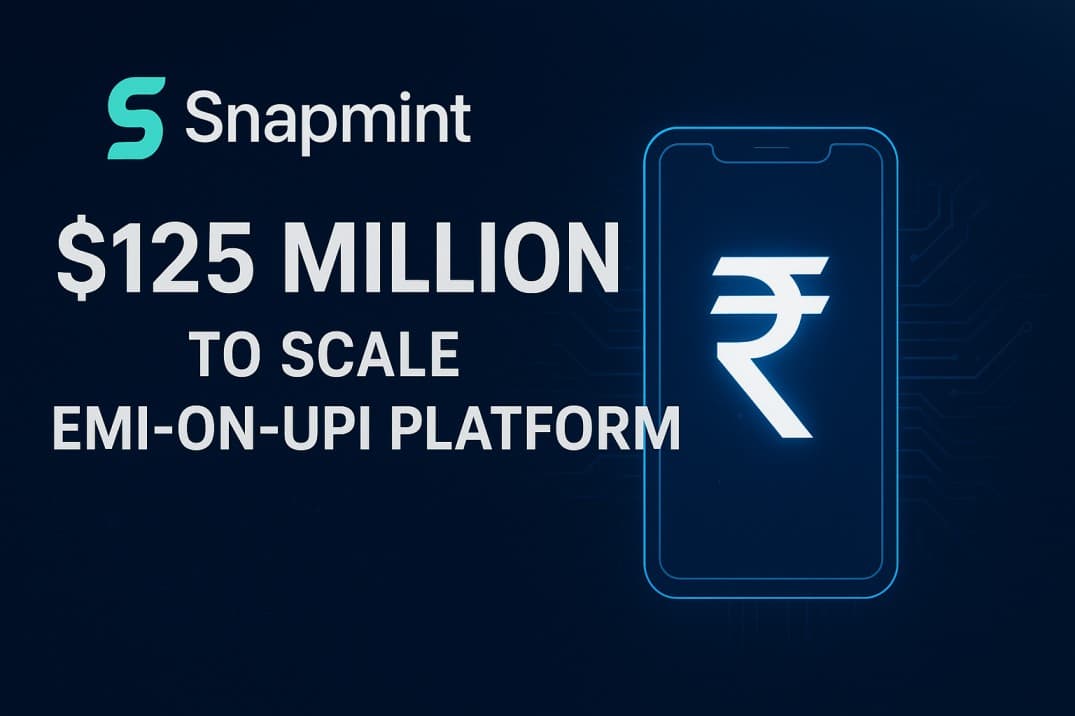Indian fintech startup Snapmint has raised $125 million in its latest funding round, led by global growth investor General Atlantic, signalling a strong vote of confidence as the firm pushes its card-less EMI offering across Indian merchants and consumers. The Mumbai-based company plans to use this growth capital to scale its EMI-on-UPI (Unified Payments Interface) system, deepen its merchant partnerships, and serve the “next 100 million” digital shoppers.
Background / Context
Snapmint, founded in 2017 by alumni of IIT Bombay — Nalin Agrawal, Anil Gelra and Abhineet Sawa — entered India’s burgeoning consumer-financing landscape with the aim of enabling equated monthly instalment (EMI) purchases without a credit card.
The broader backdrop: India’s digital payments ecosystem has matured significantly, and alternative credit models such as EMI and “buy now, pay later” (BNPL) are gaining traction, especially among young, under-banked consumers being served by mobile apps and UPI-enabled checkout flows.
Key Developments / Details
- The round is $125 million in size, the bulk of which (about $115 million) is primary capital to fuel growth, while the remainder is secondary (providing liquidity to early investors and angels).
- Lead investor: General Atlantic. Participating investors include Prudent Investment Managers, Kae Capital, and Elev8 Venture Partners, among others.
- Snapmint currently claims:
- Over 7 million monthly active users.
- Coverage across 23,000 + pincodes in India.
- More than 1.5 million purchase transactions per month financed via its platform.
- Financial performance: For FY 2024-25, Snapmint's revenue jumped to approximately ₹158.5 crore from about ₹88.5 crore the prior year; and it turned a net profit of around ₹15 crore after a prior year’s loss.
- Use of funds: The company will invest in its in-house non-banking financial company (NBFC) operations, integrate with more merchant brands, increase its “credit-on-UPI” offerings, and deepen geographic coverage.
- Strategy highlight: Snapmint emphasises that India may "leapfrog credit cards and go straight to EMI-on-UPI."
Technical Explanation (Simplified)
At its core, Snapmint’s model allows a shopper to purchase an item online (or via partner brands) and, instead of paying the full amount or using a credit card, opt for EMI-on-UPI — i.e., using UPI payments combined with instalments over time.
Analogy: Imagine you’re buying a smartphone for ₹40,000. Instead of paying ₹40,000 upfront or using a credit card, you checkout via UPI, select the Snapmint EMI option, and pay ₹10,000 upfront and ₹10,000 over the next few months. Meanwhile, the merchant gets the full ₹40,000 sooner (minus fees), and Snapmint underwrites the instalments, possibly using alternative data — especially for new-to-credit users.
This differs from classic BNPL products, which may focus on short-term deferrals, because Snapmint emphasises longer-duration EMIs, integrates directly with UPI, and partners closely with merchants rather than acting as a generic payment gateway.
Implications
- For consumers: More access to affordable instalment payments even without credit cards, especially in smaller towns and cities, expanding purchasing power.
- For merchants: A checkout-financing option that can boost order conversions by 10-20% and expand reach into new customer segments.
- For the fintech ecosystem: The large fundraise reinforces investor appetite in India’s consumer-financing space and signals that UPI-based credit models are gaining strong traction.
- For the economy: As more consumers take controlled credit, it could drive consumption growth, especially among younger, underserved segments — though high growth also raises questions around underwriting, credit risk, and regulation.
Challenges / Limitations
- Credit risk: Serving many new-to-credit users means Snapmint’s underwriting and default management must remain robust.
- Regulatory landscape: EMI-on-UPI is still an evolving category, and policy changes could affect the business model.
- Competition: Several players in the BNPL and EMI financing space, such as ZestMoney and LazyPay, are vying for market share.
- Sustaining profitability: Maintaining profits while scaling will be challenging amid potential increases in merchant incentives and credit costs.
Future Outlook
Snapmint aims to reach 100 million consumers in the coming years. With the fresh capital, the company is likely to deepen partnerships with large brands and expand beyond electronics into fashion, home, and lifestyle segments.
Future developments could include dynamic EMI offers at checkout, collaborations with UPI wallets, or even expansion into other emerging markets. With growing investor confidence, Snapmint could become a strong contender for a future IPO or strategic partnership.
Conclusion / Summary
Snapmint's $125 million fundraise marks a major milestone for India's digital-credit ecosystem. It demonstrates that EMI-on-UPI could become the country's next big consumer-finance wave, bridging the gap for millions who don’t rely on credit cards. As Snapmint scales responsibly, its journey will be closely watched by both fintech peers and regulators.

